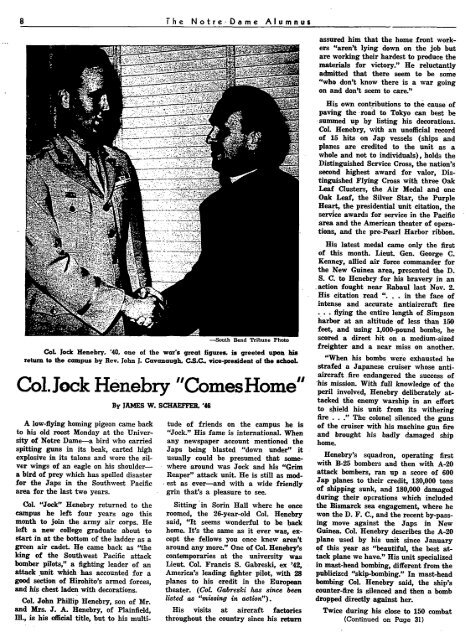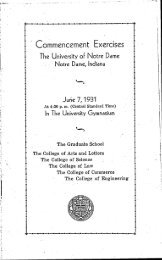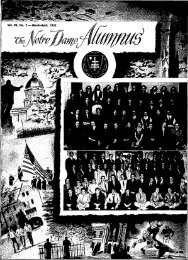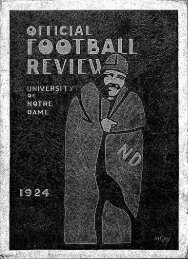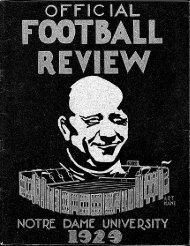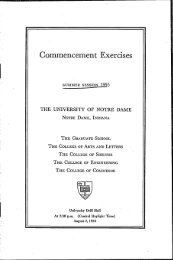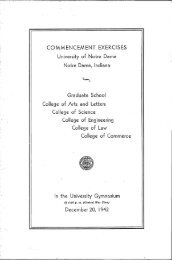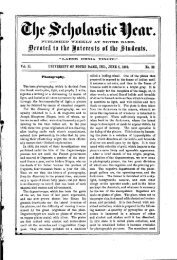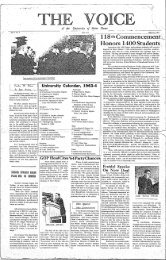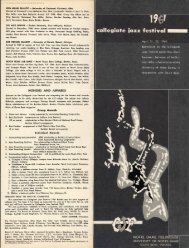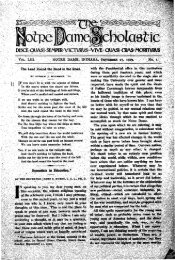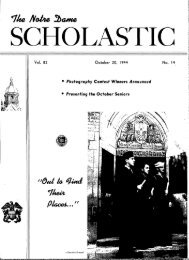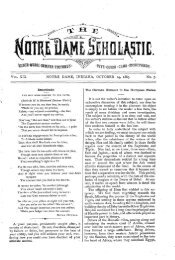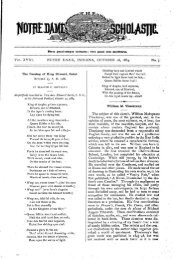Notre Dame Alumnus, Vol. 22, No. 06 -- August - Archives ...
Notre Dame Alumnus, Vol. 22, No. 06 -- August - Archives ...
Notre Dame Alumnus, Vol. 22, No. 06 -- August - Archives ...
You also want an ePaper? Increase the reach of your titles
YUMPU automatically turns print PDFs into web optimized ePapers that Google loves.
The <strong><strong>No</strong>tre</strong> <strong>Dame</strong> <strong>Alumnus</strong><br />
—South Bend Tribune Photo<br />
CSoL Jock Henebry, '40, one of the war's great figures, is greeted upon hi*<br />
return to the campus by Bev. John J. Caranough. C.S.C Tice-president of the sehooL<br />
Col. Jock Henebry "Comes Home"<br />
A low-flying homing pigeon came back<br />
to his old roost Monday at the University<br />
of <strong><strong>No</strong>tre</strong> <strong>Dame</strong>—a bird who carried<br />
spitting guns in its beak, carted high<br />
explosive in its talons and wore the silver<br />
wings of an eagle on his shoulder—<br />
a bird of prey which has spelled disaster<br />
for the Japs in the Southwest Pacific<br />
area for the last two years.<br />
Col. "Jock" Henebry returned to the<br />
campus he left four years ago this<br />
month to join the army air corps. He<br />
left a new college graduate about to<br />
start in at the bottom of the ladder as a<br />
green air cadet. He came back as "the<br />
king of the Southwest Pacific attack<br />
bomber pilots," a fighting leader of an<br />
attack unit v^ch has accounted for a<br />
good section of Hirohito's armed forces,<br />
and liis chest laden with decorations.<br />
Col. John Phillip Henebry, son of Mr.<br />
and Mrs. J. A. Henebry, of Plainfield,<br />
ni., is his official title, but to his multi<br />
By JAMES W. SCHAEFFER. '46<br />
tude of friends on the campus he is<br />
"Jock." His fame is international. When<br />
any newspaper account mentioned the<br />
Japs being blasted "down under" it<br />
usually could be presumed that somewhere<br />
around was Jock and his "Grim<br />
Reaper" attack unit. He is still as mod-<br />
• est as ever—^and with a wide friendly<br />
grin that's a pleasure to see.<br />
Sitting in Sorin Hall where he once<br />
roomed, the 26-year-old Col. Henebry<br />
said, "It seems wonderful to be back<br />
home. It's the same as it ever was, except<br />
the fellows you once knew aren't<br />
around any more." One of Col. Henebiy's<br />
contonporaries at the university was<br />
Lieut. Col. Francis S. Gabreski, ex '42,<br />
America's leading fighter pilot, with 28<br />
planes to his credit in the European<br />
theater. {Col. Gabreski lias since been<br />
listed as "missing in action").<br />
His visits at aircraft factories<br />
throughout the country since his return<br />
assured him that the home front workers<br />
"aren't lying down on the job but<br />
are working their hardest to produce the<br />
materials for victory." He reluctantly<br />
admitted that there seem to be some<br />
"who don't know there is a war going<br />
on and don't seem to care."<br />
His own contributions to the cause of<br />
paving the road to Tokyo can best be<br />
summed up by listing his decorations.<br />
Col. Henebry, with an unofficial record<br />
of 15 hits on Jap vessels (ships and<br />
planes are credited to the unit as a<br />
whole and not to individuals), holds the<br />
Distinguished Service Cross, the nation's<br />
second highest award for valor. Distinguished<br />
Flying Cross with three Oak<br />
Leaf Clusters, the Air Medal and one<br />
Oak Leaf, the Silver Star, the Purple<br />
Heart, the presidential unit citation, the<br />
service awards for service in the Pacific<br />
area and the American theater of operations,<br />
and the pre-Pearl Harbor ribbon.<br />
His latest medal came only the first<br />
of this month. Lieut. Gen. George C.<br />
Kenney, allied air force commander for<br />
the New Guinea area, presented the D.<br />
S. C. to Henebry for his bravery in an<br />
.action fought near Kabaul last <strong>No</strong>v. 2.<br />
His citation read "... in the face of<br />
intense and accurate antiaircraft fire<br />
. . . flying the entire length of Simpson<br />
harbor at an altitude of less than 150<br />
feet, and using 1,000-pound bombs, he<br />
scored a direct hit on a medium-sized<br />
freighter and a near miss on another.<br />
"When his bombs were exhausted he<br />
strafed a Japanese cruiser whose antiaircraft<br />
fire endangered the success of<br />
"his mission. With full knowledge of the<br />
peril involved, Henebry deliberately attacked<br />
the enemy warship in an effort<br />
to shield his unit from its withering<br />
fire . . ." The colonel silenced the guns<br />
of the cruiser with his machine gun fire<br />
and brought his badly damaged ship<br />
home.<br />
Henebry's squadron, operating first<br />
with B-25 bombers and then with A-20<br />
attack bombers, ran up a score of 600<br />
Jap planes to their credit, 130,000 tons<br />
of shipping sunk, and 180,000 damaged<br />
during their operations which included<br />
the Bismarck sea engagement, where he<br />
won the D. F. C, and the recent by-passing<br />
move against the Japs in New<br />
Guinea. Col. Henebry describes the A-20<br />
plane used by his unit since January<br />
of this year as "beautiful, the best attack<br />
plane we have." His unit specialized<br />
in mast-head bombing, different from the<br />
publicized "skip-bombing." In mast-head<br />
bombing Col. Henebry said, the ship's<br />
counter-fire is silenced and then a bomb<br />
dropped directly against her.<br />
Twice during his close to 150 combat<br />
(Continued on Page 31)


